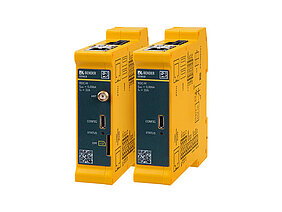Due to the permanently growing number of electric vehicles, the demand for a nationwide charging infrastructure is also increasing simultaneously. AC charging is an important aspect in this field, since these systems can be easily integrated into an existing private or public 230 V/400 V AC system.
The charge controller used takes on the role of the brain of an AC charging station of charging mode 3 according to IEC 61851-1, because the charge controller is responsible for controlling, monitoring, authorising and billing the charging process of an electric vehicle.
In addition to the above-mentioned functionalities that a smart charge controller should offer, it must at the same time provide a certain degree of economic efficiency. Bender has addressed precisely this problem with its new CC613 charge controller generation. With the CC612, Bender already offers a smart charge controller whose range of functions has now been significantly expanded.
The CC613 features an integrated Ethernet interface, which allows direct and easy integration of the controller into an existing Ethernet network. The Ethernet interface now provides a direct and convenient way to set up a networked charging infrastructure that can be easily maintained and controlled remotely. A further innovation is the integrated emergency opener. In the event of a power failure, the emergency opener unlocks the charging connection at the charging station so that the charging plug can be removed safely. The advantage is that no additional components are required for plug release or wiring, which reduces costs and allows a more compact charging station or wallbox design.
In terms of electrical safety, the CC613 has been extended by a "weld check" function, which detects "sticking" of the contactor. Furthermore, the CC613 offers continuous PE monitoring, which ensures that the PE connection to the controller is properly established. With the newly integrated 230 V control relay, the contactor can be switched directly with the controller for power release on the vehicle side. An additional relay is no longer necessary, which further reduces the cost of a charging point.
In order to be able to control the charge controller by means of a higher-level system (e.g. energy management system), the CC613 also has an external Modbus interface. This innovation enables the operator of a charging infrastructure to remotely control the controllers regardless of a backend connection (enabling users, maximum charging current, etc.).
Due to the almost unchanged and compact design of the CC613 (112. mm x 23.5 mm x 99 mm) compared to the CC612, the charge controller can be perfectly integrated into small charging stations or wallboxes in a cost-effective way. In order to make optimum use of the advantages of the CC613, existing charging stations can be easily upgraded to the new generation of charge controllers thanks to the unchanged design. For interaction with a backend system, the CC613 is compatible the communication protocol OCPP 1.5 and 1.6 (JSON & SOAP).
The CC613 also features the Powerline Communication (PLC) standard according to ISO/IEC 15118 for plug & charge and for networking the charge controller with an energy management system. The third generation of the Bender charge controller also offers dynamic load management (DLM), which allows a smart and optimal distribution of the available power among all charging points.
To optimise and minimise the costs of a charging station, the CC613, like its predecessor CC612, is equipped with DC fault current detection in accordance with IEC 62955, which makes it unnecessary to use an RCD type B. The use of a significantly less expensive RCD type A is sufficient.
New product features at a glance:
- Integrated Ethernet interface enables Modbus TCP communication and an energy management connection via EEBUS
- Compliance with the IEC 62955 standard
- The integrated DLM (dynamic load management) is continuously extended by further functions, but can also be overwritten by higher-level systems
- The control for the plug emergency opener is integrated in the modified enclosure
- Continuous PE monitoring ensures that the PE connection is connected correctly
- Software updates are still available
